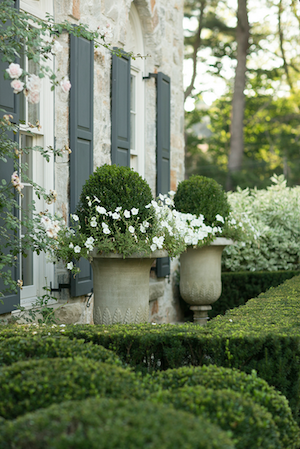
Palladio-winning Christopher Newport Hall during CNU commencement, 2015.
The Palladio Awards may not get the attention of the Driehaus Prize, which does not get the attention of the Pritzker Prize. But the Palladios are the first and only national architecture award that recognizes specific traditional projects and their design teams.
The 2016 Palladio Awards have been announced by the award program’s sponsor, Active Interest Media. The commercial/institutional winners will appear in the June issue of Traditional Building; and the residential winners will appear in the July issue of Period Homes. They will all be celebrated on July 19 during the Traditional Building Conference at the Lawn Club, in New Haven, Conn. (Each winner’s photo at the link above can be clicked to view the identity and details of the winning submission.)

Winner, Exterior Space
Because both the Pritzker and the Driehaus prizes recognize the life work of their winning architects, they play a different role in the conversation over architecture. The Palladio awards celebrate specific projects in order to identify their techniques and to track progress in the discourse. Unlike the two more widely known awards, the purpose of a program such as the Palladio is not only to reward well-established talent but also to encourage young talent coming up.
For traditional architects, artists, artisans and designers, a target-rich environment for awards exists. The Driehaus is joined not only by the Arthur Ross Awards of the Institute of Classical Architecture & Art, the Stanford White Awards of the ICAA’s New York chapter, and a host of awards programs sponsored by an increasing roster of the institute’s 15 or so regional chapters, such as the Bulfinch Awards recently celebrated by the New England chapter. I hope that I will hear about those of which I am unaware or that I have forgotten to mention.
Granted, these bouts for honor in the traditional sphere of architecture represent, sadly, a fraction of the camp followers of the Pritzker that litter the landscape of bad architecture schools and self-indulgent professional organizations such as the American Institute of Architects and its ilk.
But laureates in such competitions pick up their medals, scrolls, plaques, statuettes and other paraphernalia of victory with, one must suppose, a sour taste in their mouths and a glance over their shoulders. This is because in spite of a hundred years of modern architecture, the style has yet to achieve legibility beyond the frothy interpretation of modernist scholarship and the mod-symp media, or to develop a formal language by which juries may judge the relative worth of designers, projects or, indeed, entire careers.
If you were to take all the winners of the Pritzker Prize since its inception in 1979, and throw them into competition for a new prize for the greatest modernist architect in history, a jury would have no plausible or systematic way to select a victor. It would be the founders’ boring purity of line versus, in recent decades, the latest whackadoodle de jour. How to choose? There is virtually no way to choose that has anything to do with architectural craft or principle. I suspect winners of the Pritzker realize this, and their silence is assured by dint of the $100,000 doled out to each year’s Pritzker laureate.
The winners of a Palladio, however, when they walk off the podium in New Haven with applause ringing in their ears, they will know that their prizes were chosen by juries weighing the merits of their work against the standards of an achitectural language that has grown, alongside the evolution of civilization, over two and a half millennia.
Pritzker laureates may well laugh all the way to the bank, but on their way, as the number of awards programs for traditional work expands, those “winners” will be whistling past the graveyard if Truth, Justice and the Palladian Way have any say in the matter.



Hello David,
Thanks so much for that wonderful blog about the Palladio Awards!!
It is very much appreciated.
Martha
Martha McDonald, Editor Traditional Building magazine http://www.traditional-building.com
________________________________
LikeLike
Aim to please!
LikeLike
Hi David,
Thanks for all of your great posts! I was wondering if you could elaborate on the various awards themselves. For example, what do the Palladio & the ICAA chapter’s awards look like? Who came up with the designs?
Thanks,
J. Hovis
LikeLike
Interesting question. The Driehaus prize is a small model of the Choregic Monument of Lysikrates, in Athens, the first use of the Corinthian order outside of the context of a building. The Bulfinch award is a bronze medal with the head of Charles Bulfinch, said to be the first architect trained as such in the U.S. Winners of the Palladio receive a trophy called The Palladium, designed and cast by Historical Arts & Casting of West Jordan, Utah. I do not know what it looks like. The Ross Award, when I won one in 2002, was a finely inscribed document in the memory of Arthur Ross, a founder of Classical America, which is now the ICAA. I suspect that it has been upgraded since then but I have no information on how so.
I’m afraid that’s all the info I have off the top of my head. Will transmit anything else that comes my way.
LikeLike